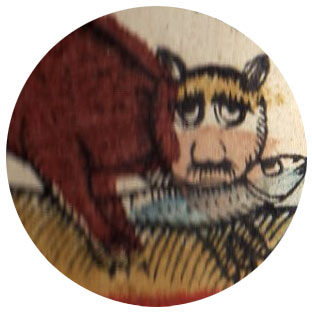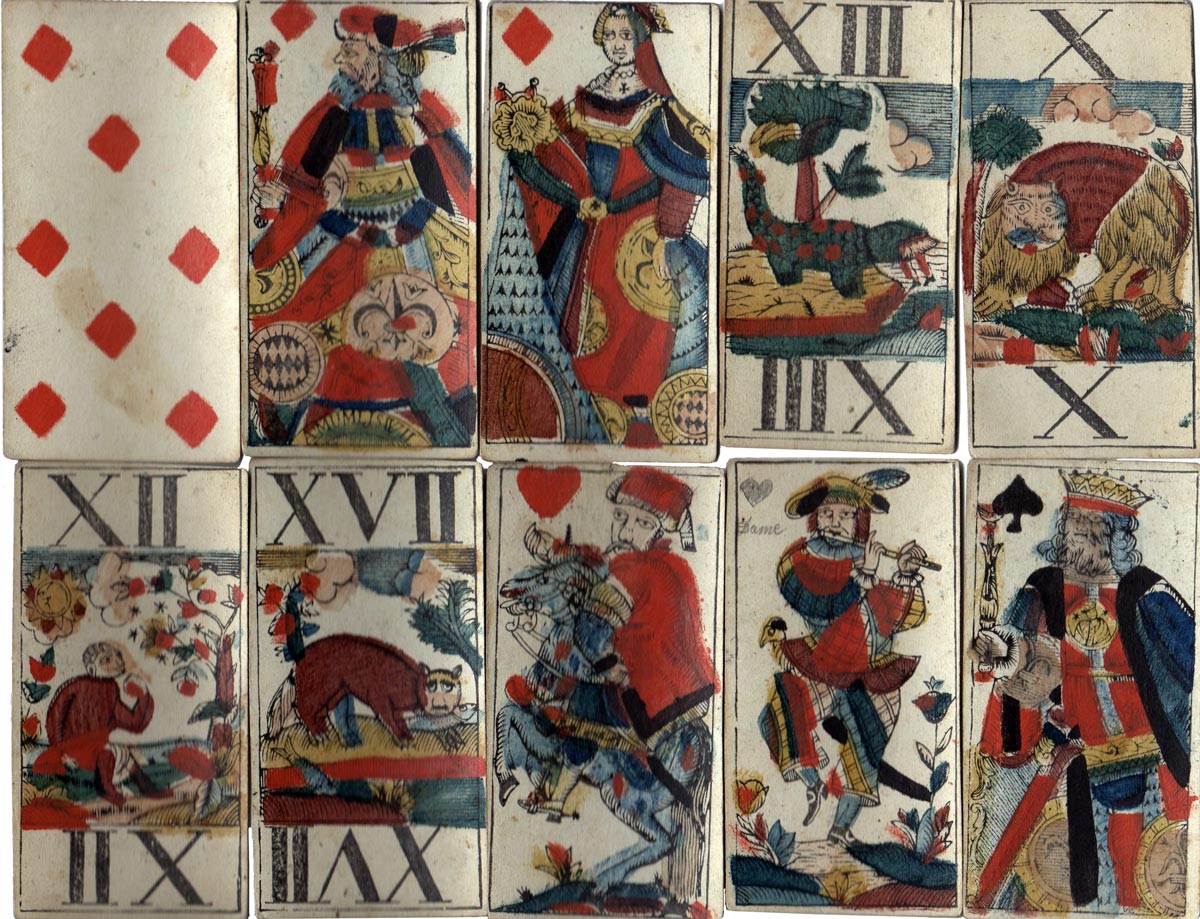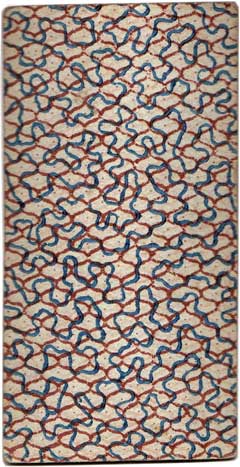Animal Tarot
Woodblock and stencil Animal Tarot cards, probably of Swiss origin, 2nd half 18th century.

Bavarian Animal Tarot
Tarots with French suit signs started appearing in around 1750, notably by Andreas Göbl of Munich. Subjects depicted on the trump cards varied, but during the 18th century there was a preference for pictures of animals or hunting scenes. The number cards were often reduced so that packs consisted of only 54 cards. Towards the end of the century mythological and literary subjects started to appear as well. The Fool was usually depicted as a harlequin, often dancing and playing a musical instrument.
As they have no titles or legends, the images on the trump cards must speak for themselves. Sometimes they appear to depict fables or folk sayings, perhaps even suggesting a moralising interpretation. In trump XIII we see a person being devoured by a crocodile: this is indeed unfortunate! On trump XVII a cat has caught a fish...


Above: woodblock and stencil Animal Tarot cards, probably of Swiss origin, 2nd half 18th century. The city of origin seems to be indicated at the bottom of the King of Diamonds (A Mumijswii) but it is a real challenge to decipher. This is the most usual form of Bavarian Tarot, with panels at the top and bottom of the trump cards containing their value in Roman numerals. Lozenges of the Bavarian arms can be seen on the round shields of the King and Queen of Diamonds. Other decorative features on the court cards suggest a derivation from the old Paris pattern. The 'Fool' card in this example has been reassigned as the Queen of Hearts by a previous owner. Images courtesy Frederic C. Detwiller.
See also: Danish Animal Tarok cards by Jean Friedrich Mayer (1752-1783) • Jacob Holmblad Animal Tarot c.1835
FURTHER READING
Mann, Sylvia: All Cards on the Table, Jonas Verlag/Deutsches Spielkarten-Museum, Leinfelden-Echterdingen, 1990
Note from FREDERIC DETWILLER - additional background history
These cards were owned by my 3 x great grandfather Jacob Detwiller of Langenbruck Switzerland near Basel. Since the town of Mümliswil is in Canton Solothurn next door to Canton Basel, it seems likely that was where they may have been printed and where they may have been acquired with inscription in French: "Å MUMLISWIL".
Detwillers have lived in Langenbruck since at least the 16th century. The cards were found by my Gr. Grandfather J.J. Detwiller and my grandfather CH Detwiller in a silver cigar(?) case along with some brass dice in his hunting lodge at Neunbrunnen (Nine Springs) when Jacob died 1878. The house is still extant as a Gasthof (see old view: www.gast-hof-spittel.ch/►
We also inherited a couple of Swiss-German 17th-18th century hunting swords (and the bronze stag hooks from which they hung in the dining room at the Neunbrunnen lodge. The hunting swords (and perhaps the tarot cards) probably originally belonged to 4 x Gr. Grandfather Heinrich Dettwiler (1760-1814, or his father of same name b.1718) of Langenbruck. The first to settle in Langenbruck was Jacob Dätwyler (old spelling) of Saget near Zofingen in 1582.

Thanks again to Marc Flöter for your information in the comment below - F.D.

By Simon Wintle
Member since February 01, 1996
I am the founder of The World of Playing Cards (est. 1996), a website dedicated to the history, artistry and cultural significance of playing cards and tarot. Over the years I have researched various areas of the subject, acquired and traded collections and contributed as a committee member of the IPCS and graphics editor of The Playing-Card journal. Having lived in Chile, England, Wales, and now Spain, these experiences have shaped my work and passion for playing cards. Amongst my achievements is producing a limited-edition replica of a 17th-century English pack using woodblocks and stencils—a labour of love. Today, the World of Playing Cards is a global collaborative project, with my son Adam serving as the technical driving force behind its development. His innovative efforts have helped shape the site into the thriving hub it is today. You are warmly invited to become a contributor and share your enthusiasm.
Related Articles

Julius Berndl and his Austrian tarock
Josef Glanz's Tarock: a classic deck with artistic innovation by Julius Berndl.

Gigerl-Tarock by Joseph Glanz
Urban Dandy caricature deck from 19th century Vienna designed by Julius Berndl.

Tarock Nr. 71 by Ferd. Piatnik & Söhne
Special tarock deck for the Tyrolean game Droggn.

Animal Tarock by J. G. Pichler
Baroque tarock cards from the late 18th century.

Modern Swiss-German Pattern (carta.media)
Modernizing tradition: balancing clarity and continuity in regional card design.

Zürcher Festspiel 1903
Swiss-suited pack designed by Robert Hardmeyer featuring figures from art and politics.

Austrian Tarock by S.D. Modiano
Modiano’s Austrian Tarock with country scenes has been in production for over 100 years.

Tarock Cards by NIL Spielkartenfabrik
A deck of tarock cards from the eastern end of the ending Austro-Hungarian Empire.

Alan Tarot Deck
Reprint of a Tarock pack originally designed by Argio Orell for the Austrian Lloyd shipping company....

Modern Jass (Fredy Sigg)
Caricatural updating of traditional Swiss Jass cards by the artist Fredy Sigg.

Swiss playing cards by Iehan Hemau
17th century Swiss-suited playing cards by Iehan Hemau of Épinal.

Jeu de Tarot (Catel & Farcy)
Colourful version of a standard French (‘Bourgeois’) Tarot.

Johann Nejedly Tarok Cards
Johann Nejedly, a 19th-century Viennese card maker, produced Tarock cards featuring modern scenes th...

Paris 2024 Olympics 2
A standard French Tarot game pack with passing references to the Paris 2024 Summer Olympic Games.

Joseph Sürch, Engraver
Joseph Sürch, a prominent Viennese engraver, made significant contributions to card sheet engraving ...

Tarot – Images du Pays Basque
Seventy-eight photographic images of the French Basque Country on a pack for playing the game of Tar...
Most Popular
Our top articles from the past 28 days

